Rigid Hull Inflatable Boats (RHIBs)
Built for Rescue
Almost every major Navy and Coast Guard has them in their inventory.
No, their not named, and they aren’t usually found in
Jane’s Fighting Ships either. But, they are an important
part of many major sea services. What type of vessel are they?
They are Rigid Hull Inflatable Boats, commonly referred to as
RHIB’s or RIB’s.
What exactly is an RHIB?
They are typically glass-reinforced or aluminum hulls to which
a multi-compartment buoyancy tube is attached. RHIBs have stringers
and which support a molded deck. In addition, for rescue RHIBs,
they also have a removable collar that has multiple air chambers,
each fitted with separate fill and relief valves.
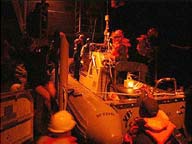 |
Deck
Department personnel prepare for a night launch of a Rigid
Hull Inflatable Boat aboard the amphibious assault ship
USS Kearsarge. (click to enlarge) |
Many of the collars have a built-in bolt-rope system to enable
other boats or people to grab hold of, during a rescue. These
collars also allow impacts to be absorbed, protecting the rest
the molded deck and personnel. The collar, which is removable,
expedites repairs or replacement. The inflatable collar makes
the RHIB extremely versatile by providing high stability and
the ability to fender off vessels without damage.
Powered by either a single or dual gasoline or diesel engines,
with either outboard, inboard/outboard stern drive, or jet drive,
these boats can carry as few as three and some as many as eighteen
people. Speed is dependent on the size and power plant, but
some can reach speeds in excess of 40 knots.
Why are they so popular as a rescue vehicle?
There are several reasons why RHIBs have gained in popularity
as both recreational as well as rescue craft. Prime among these
is the durability of the craft for many types of sea states.
The United States Coast Guard requirement for its new WPB (87’"Marine
Protector Class" Coastal Patrol Boat (CPB)) was that the
patrol boat be able to operate in Sea State Five (10 foot waves)
and launch and retrieve a small craft in Sea State Four (7 foot
waves).
RHIBs have the ability to withstand these unfavorable sea
conditions, as well as absorb the beatings that these wave heights
that would stress traditional fiberglass or wood vessels.
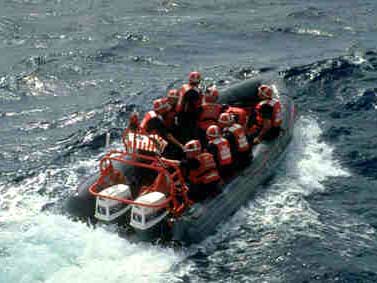
USCG RHIB on patrol
The large availability of different manufacturers and power
plants has also added to their popularity. Most RHIBs are available
in SOLAS (Safety of Life at Sea) and non-SOLAS standards.
Other reasons for the popularity of RHIBs in the rescue community
include its ability to provide a fast response and its shallow
water capabilities. These factors make RHIBs an excellent vessel
for conducting the Law Enforcement as well as rescue missions.
In a report title “Worldwide Assessment of Stern Launch
Capability” by Rubin Sheinberg, Christopher Cleary, and
Thomas Beukema of the U.S. Coast Guard’s Engineering Logistics
Center spoke about the advantages of the RHIB:
The outboard powered RHIB is very responsive to throttle
and very maneuverable. All the diesel powered small boats
used water jet propulsion with the exception of the Navy’s
7-meter RHIB that used an I/O drive. The larger 11-meter boats
used twin water jets for propulsion. The advantage of the
water jets is there is no appendage that hangs below the hull
to interfere with launch and recovery operations.
Hy-Seas
Inflatable Boats has produced inflatable boat tubes used
by the Sidney Search and Rescue (Sidney, Vancouver Island,
British Columbia, Canada) (click to enlarge) |
|
RHIBs in action
Rescue services from Canada to Australia, Great Brittan to
the United States rely on Rigid Hull Inflatable Boats to service
inland, bay, near coastal and ocean rescues, law enforcement
and environmental missions. It is because these vessels offer
such a wealth of different mission platform support, that they
have become indispensable tools of the International Search
and Rescue (SAR) Community.
Here are some short stories of these infamous vessels in action:
The Canadian Coast Guard (CCG) along with the Royal Canadian
Mounted Police (RCMP) intercepted a vessel that was engaged
in illegal transportation of undocumented Asian aliens. When
finally intercepted, the CCG found 100 persons on the beach
-- cold and wet and bewildered. The CCG using only a rigid-hull
inflatable boat (RHIB), demonstrated their faith in their vessel,
forging through dense fog and swell. Hour after hour, rescue
trip after rescue trip, they plied waters containing rocks and
other debris. All in all, they rescued 133 illegal Asians from
the beach.
“Coast Guard’s Rigid Hull Inflatable Operator
Training (RHIOT) program in Bamfield that’s considered
one of the best in the world for this specialized training.
The school has been in operation since 1984. Since then, more
than 1,536 rigid hull many groups that use RHIBs in challenging
and often dangerous conditions,” Kevin Tomsett said. “Our
program is in such demand because we’ve got the perfect
training ground, lots of cumulative experience, and excellent
instructors.”
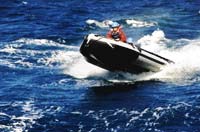 |
Her Majesty’s
Royal New Zealand RHIB on patrol. (click to enlarge) |
A recent class included a … a 23-year old female UVic
student and member of the Oak Bay Coast Guard Auxiliary…
The week-long course is held only in winter, when the seas are
at their roughest. “We like to put the students through
the worst conditions possible,” Bill Mather, Chief Instructor
at the school, said.
The course comprises classroom work, hands-on instruction,
and real life training out on the ocean. Students study high-speed
obstacle avoidance maneuvers, station-keeping close in to rocks
and cliffs and the proper way to drive big waves. They attend
lectures on wave theory that examine the differences between
various waves—what makes them refract and break and move
like they do. There are classes dedicated to using sophisticated
navigational tools like DGPS and radar.
Students learn proper care for RHIBs including how to repair
leaks, how to restart engines that have been submerged and how
to right an overturned RHIB. There are sessions on how to use
an overturned boat for protection, how to get back into a boat
if you have fallen out, and how to get victims into the boat.”
-
By Kendra Helmer, Stars and Stripes -
European edition, Wednesday, April 9, 2003
“ABOARD THE USS GARY — Half-blinded by sea spray,
the U.S. sailors yelled and gestured for the Iraqi fishermen
to jump off their sinking ship.
Fifteen-foot waves tossed the sailors around and sucked their
inflatable boat toward the listing, spinning trawler.
“I didn’t think at any time we’d get all
eight of them or that we’d all make it back ourselves,”
said Ensign Ryan Easterday, officer of the rigid-hulled inflatable
boat launched from the USS Gary…”
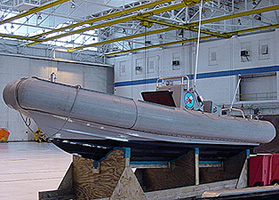
The Rigid Hull Inflatable Boat (RHIB) is operated by crew
members from NAVSTA Norfolk Detachment. It is used for Helicopter
Squadron Support during search and rescue training in Willoughby
Bay area. The RHIB is also used for coastal launch zone protection
during BQM launching operations.
Performance Details
| Speed: |
33 |
kts |
| Range: |
150 |
nm |
| Length: |
23 |
ft |
| Beam: |
8 |
ft |
| Weight: 5603 lbs |
|
|

Sidebar
A Brief History of RHIB’s in the
Coast Guard
By Armand L. Chapeau, CDR, USCG, (ret)
CO, USCGC ALERT 1980-1982
The RHIB was prototyped for the Coast Guard onboard
USCGC ALERT (WMEC-630) then home ported at Cape May, New Jersey
from 1979 - 1983. The crew called it the “rubber duck.”
During my tenure as Commanding Officer the RHIB was directly responsible
for the saving of 15 lives over my two year command period.
In the fall of 1980, the Sailing Vessel MARIAH was taking on
water in 50 –70 knot winds and 30-40 foot seas about 200
miles Southeast of Cape May. There were seven persons on board.
An H-3 helicopter out of Elizabeth City managed to rescue two
of the occupants by picking them off a trailing life raft.
Before the others could be removed the raft deflated. We arrived
on scene in the early morning hours and even though rolling about
35-40 degrees launched the RHIB and rescued the remaining five
occupants.
| Navy Awards SBIR Phase I Hybrid
Electric Boat Contract to STI, 7 meter rigid hull will carry
generator, batteries, motors, controllers. Current configuration
has diesel enginewith stern drive or twin outboards (click
to enlarge) |
|
The rescue would not have been possible using the standard ships
fiberglass boat as it would have been smashed against the hull
of the ALERT. The ship got a Coast Guard Unit commendation for
that rescue and the boat crew received Coast Guard Commendation
Medals.
In the fall of 1981 strong low developed about 300 miles south
of Cape Fear and caught a number of vessels off guard. ALERT having
just departed Charleston was ordered to assist. With winds topping
70 knots and breaking seas on scene we arrived at the first vessel,
an 80 foot sailing vessel with one crewman.
The RHIB was launched and just before they got to the sailboat
it pitch poled, throwing the one occupant into the sea. A crewman
in the RHIB snatched him on board and returned to the ALERT. 12
hours later battling the same weather conditions, we reached another
sailboat with a single occupant and repeated the drill.
Another twelve hours went by and we arrived at a third sailing
vessel with a merchant ship standing by and again retrieved the
sailboat crew of four with the RHIB in the same adverse conditions.
Another 12 hours saw ALERT again launching the RHIB to rescue
four more off another sailboat.
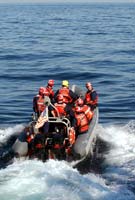 |
RHIB leaves
the CGC Escanaba (WMEC-907) on patrol. (click to enalrge) |
The weather had moderated enough to get a towline on this vessel
and tow it to another cutter to take into port. ALERT then headed
for Little Creek, Virginia to repair storm damage. As we were
tying up with four brooms at the mast, the sounds of “You
Can Take This Job and Shove It” broke out on the ships PA
system after the playing of “Semper Paratus” followed
by “Victory at Sea.”
The ship was awarded a Coast Guard Unit Commendation for the
rescues, the crew of the RHIB Coast Guard Medals, and the RHIB
became a standard for the fleet.

|

